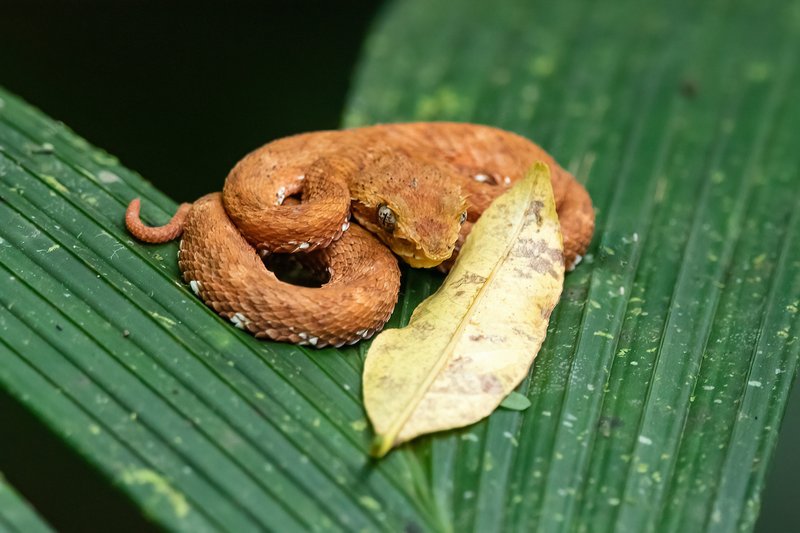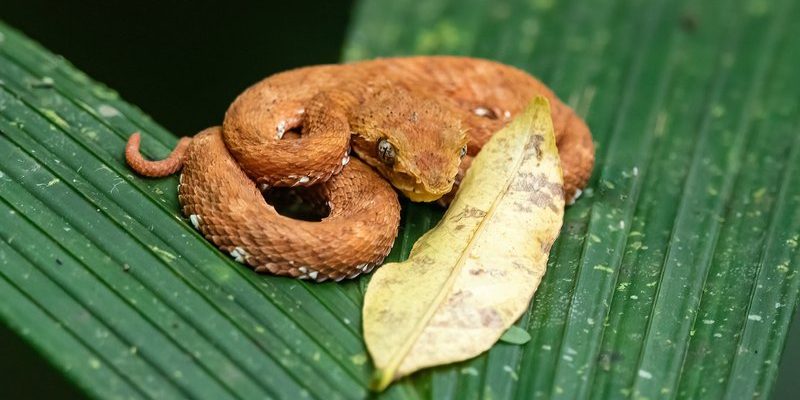
The Eyelash Viper (bothrops schlegelii) is relatively small, averaging about 2 to 3 feet in length. What really sets it apart are its distinctive, horn-like scales above its eyes, which look like eyelashes—hence the name! This unique feature aids in camouflage, allowing the snake to blend seamlessly with its surroundings. Imagine trying to spot one of these beauties resting on a branch or curled around a tree stem; it’s not easy!
The body of the Eyelash Viper is not only adorned with colors but also covered in a variety of scales that can feel quite different depending on where you touch it. The scales on the back are typically rough, helping with grip as the snake moves through the trees, while those around the belly are smoother. The snake’s eyes are also something to note; they have vertical pupils that give it a striking appearance and enhance its ability to see in low light conditions, making it an adept hunter.
In terms of their coloration, these snakes can exhibit a wide range—from deep greens to bright yellows, and even patterns resembling a checked board. This variety is not just for show; it plays a crucial role in each individual’s survival. Those that are better camouflaged can avoid predators, while those with bright colors may advertise their venomous nature to potential threats.
Habitat and Distribution
Eyelash Vipers primarily inhabit tropical rainforests and cloud forests, which are rich in biodiversity. They can be found in countries like Costa Rica, Panama, Colombia, and Ecuador. Living in these lush environments, they often elevate themselves up into the trees—this is where their colorful hues help them stay hidden from both prey and predators.
These snakes prefer wet, humid areas and can also be found near rivers and streams where they can find plenty of food. The Eyelash Viper’s ability to adapt to different levels of humidity and temperature allows it to thrive in various microclimates within their habitat. When you think of a rainforest, imagine the cacophony of colors, sounds, and movements—this is the Eyelash Viper’s home!
You might find them basking on branches or coiled around plants, waiting patiently for their next meal. They are primarily arboreal, meaning they spend most of their lives in trees. This lifestyle not only helps them avoid many ground predators but also puts them closer to their main prey: small mammals, birds, and lizards. They often use ambush tactics, remaining still until an unsuspecting target comes close enough to strike.
Diet and Hunting Techniques
The diet of the Eyelash Viper consists mainly of small mammals, birds, and occasionally, other reptiles. What’s interesting here is their hunting strategy. Unlike some snakes that chase after their prey, Eyelash Vipers employ a more patient technique: they ambush. Picture this: the snake remains perfectly still, blending into the foliage, waiting for an unsuspecting animal to wander by. When its moment comes, it strikes with lightning speed, using its venom to paralyze or kill its catch.
Speaking of venom, the Eyelash Viper’s venom is hemotoxic, meaning it can destroy blood cells and affect circulation. Though it is potent enough to subdue its prey quickly, it’s not considered particularly dangerous to humans—unless provoked, of course! You might be surprised to learn that they often prefer to retreat rather than confront a human. This behavior further highlights their adaptability and clever survival strategies.
After capturing their prey, Eyelash Vipers use their sharp, curved fangs to deliver the venom effectively. Once the prey is immobilized, the snake swallows it whole. They can consume prey that is larger than their head, making their feeding quite efficient. In the wild, the hunt is not merely about sustenance; it’s a game of patience, precision, and survival.
Reproduction and Lifespan
Eyelash Vipers are ovoviviparous, which is a fancy term meaning that the females give birth to live young rather than laying eggs. In the wild, the breeding season typically occurs during the rainy months when food is plentiful. Following a gestation period of about 6 to 7 months, a female can give birth to anywhere from 3 to 20 young snakes, depending on her size and health.
After giving birth, the mother does not provide any care for her offspring. The baby Eyelash Vipers are miniature versions of their parents—complete with color patterns and venom. They are born with a keen instinct to hunt, allowing them to fend for themselves almost immediately. This rapid development is essential given that they face numerous threats, including predators like birds of prey and larger snakes.
Conservation Status
The Eyelash Viper is currently classified as “Least Concern” by the IUCN, meaning it is not at immediate risk of extinction. However, this doesn’t mean all is well. Their lush rainforest habitats are threatened by deforestation, agriculture, and climate change. As humans continue to encroach on natural spaces, the delicate balance of ecosystems is disrupted.
Conservation efforts are essential to ensure that these fascinating snakes continue to thrive in the wild. Creating protected areas, promoting sustainable land use practices, and raising awareness about the importance of biodiversity can all contribute to the Eyelash Viper’s survival. After all, every creature has its place in the circle of life, and losing any of them can have a significant impact on the environment.
By supporting conservation initiatives and educating others about the species, we can help safeguard their future. Every step counts, whether it’s reducing plastic use, supporting eco-friendly products, or simply spreading the word about the Eyelash Viper’s plight.
Interesting Facts About the Eyelash Viper
| Scientific Name: | Bothrops schlegelii |
| Average Length: | 2 to 3 feet |
| Distribution: | Central and South America |
| Diet: | Small mammals, birds, reptiles |
| Venom Type: | Hemotoxic |
| Lifespan: | 10 to 15 years in the wild |
FAQ
What does the Eyelash Viper eat?
The Eyelash Viper primarily feeds on small mammals, birds, and lizards. Its diet can vary based on what is available in its habitat. The snake uses its ambush strategy to catch prey, waiting patiently until it strikes with its venomous fangs.
Where can I find Eyelash Vipers in the wild?
You can find Eyelash Vipers in tropical rainforests and cloud forests, mainly in Central and South America. Countries like Costa Rica, Panama, and Colombia are prime spots. They often stay hidden among the branches and foliage, making them challenging to spot.
Are Eyelash Vipers dangerous to humans?
While the Eyelash Viper is venomous, it is not considered a significant threat to humans unless provoked. Most bites occur when the snake is accidentally stepped on or handled. It’s best to admire them from a distance to avoid any risks.
How do Eyelash Vipers reproduce?
Eyelash Vipers are ovoviviparous, meaning they give birth to live young instead of laying eggs. The female typically births between 3 to 20 baby snakes, which are miniature versions of adults and are capable of hunting immediately.
What is the lifespan of an Eyelash Viper?
In the wild, an Eyelash Viper can live approximately 10 to 15 years. Those in captivity may live longer due to the absence of predators and consistent food supply, along with appropriate care.
Can Eyelash Vipers change color?
No, Eyelash Vipers cannot change color like some other reptiles. However, their natural coloration is adapted to their environment, providing excellent camouflage. Their colors can vary significantly among individuals, which helps them blend into their surroundings.
What adaptations help Eyelash Vipers survive?
Eyelash Vipers possess several adaptations that help them in survival. Their vibrant colors offer camouflage, while their vertical pupils enhance low-light vision. Additionally, their unique horn-like scales on their heads assist with blending in with tree foliage.
How do we help protect Eyelash Vipers?
To help protect Eyelash Vipers, we can support conservation efforts aimed at preserving rainforests and their ecosystems. Reducing deforestation, participating in eco-friendly practices, and raising awareness about the species can make a difference.
Are Eyelash Vipers aggressive?
Generally, Eyelash Vipers are not aggressive unless threatened. They prefer to avoid confrontation and will often retreat when approached. It’s important to respect their space if you encounter one in the wild.
What role do Eyelash Vipers play in their ecosystem?
Eyelash Vipers play a crucial role as predators in their ecosystems. By controlling the populations of small mammals and birds, they help maintain a balanced environment. Their presence indicates a healthy, functioning ecosystem.
What are common threats to Eyelash Vipers?
Common threats to Eyelash Vipers include habitat destruction due to logging, agriculture, and climate change. These factors can lead to a decline in their populations and the overall biodiversity of their habitats.

